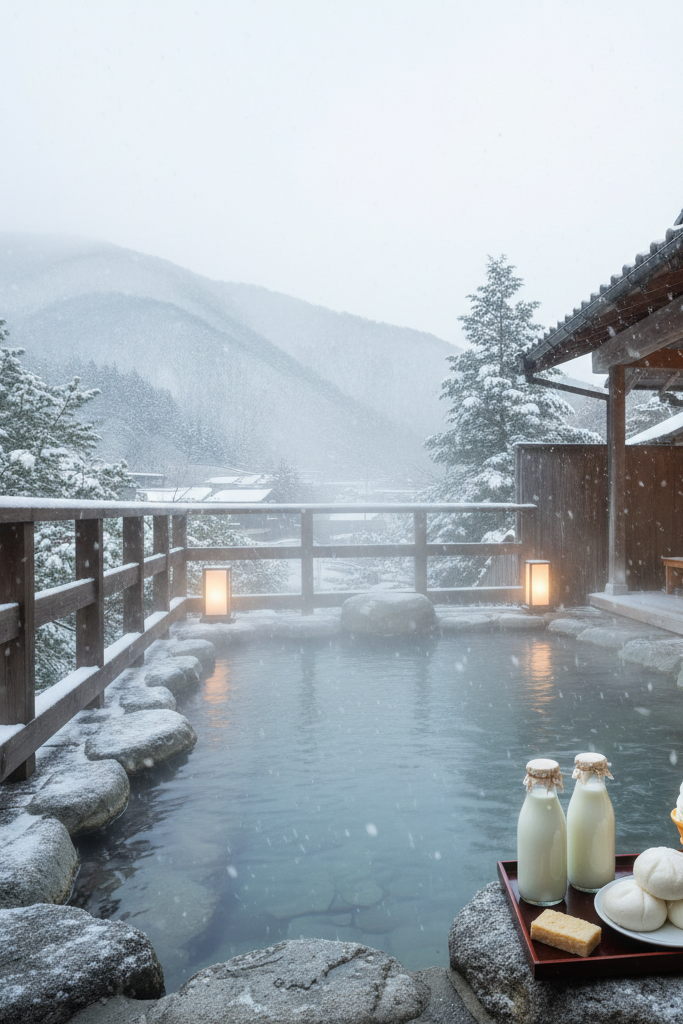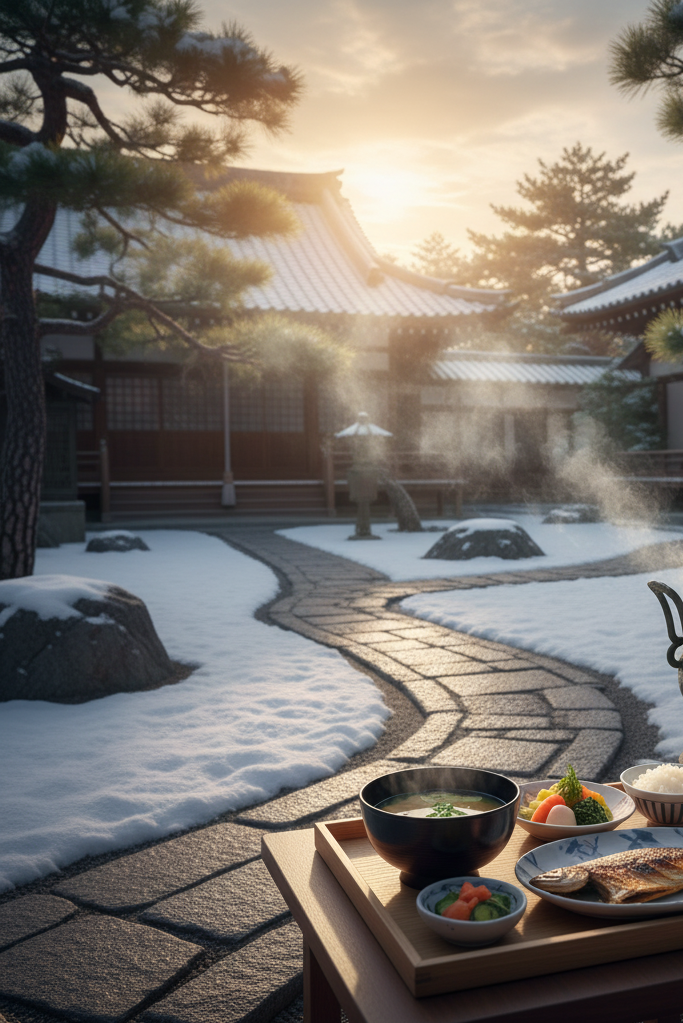
Christmas in Japan is a warm mix of Western influence, modern traditions, and unique Japanese tastes. While Christmas isn’t a religious holiday for many families, it has turned into a time full of shining lights, romantic outings, and special meals that bring people together. From crispy KFC shared on Christmas Eve to delicate strawberry shortcakes enjoyed at candlelit tables, Christmas food in Japan has become a cultural ritual that creates memories as magical as the season itself.
These 8 Christmas memories from Japan capture the smells, textures, and feelings that make holiday food an important part of winter. Whether you have experienced these traditions or are finding out about them for the first time, each story shows why Japanese festive dishes and small winter rituals stick with you.
1. The Christmas Eve KFC Tradition: A Crispy Memory Shared Across Japan 🇯🇵

One of the most iconic Christmas memories in Japan starts with a simple bucket of chicken. Since the 1970s, Kentucky for Christmas has become a nationwide trend. It is so popular that families pre-order their meals weeks ahead.
A Moment Filled With Warmth
Imagine unwrapping a warm, family-sized KFC box on Christmas Eve. The air fills with the comforting smell of seasoned fried chicken. The sounds of festive commercials, soft Christmas music, and the excitement of gathering around the table create a cozy, joyful scene.
Cultural Background
The tradition started as a marketing campaign but soon became a beloved modern ritual. For many Japanese families, it represents togetherness, convenience, and kicking off the holiday with something joyful.
Why It Matters
Sharing that bucket of chicken feels like sharing a moment of joy. It is simple, nostalgic, and uniquely Japanese.
Relatable Takeaway
Holiday memories don’t have to involve big meals. Sometimes, it’s the joy of sharing familiar food that makes a tradition special.
2. Strawberry Shortcake: Japan’s Most Beloved Christmas Dessert 🇯🇵

No Japanese Christmas is complete without the iconic strawberry shortcake. It features a light sponge cake layered with whipped cream and topped with shiny red strawberries.
A Sweet Symbol of the Season
Picture a perfectly round, snowy-white cake glowing under soft holiday lights. When you slice it, the cream melts a bit, the sponge feels light and tender, and the strawberries give off a sweet winter scent.
Cultural Background
Strawberries are available in winter, making them a special seasonal treat. Over time, this dessert has become Japan’s symbol of celebration, purity, joy, and shared sweetness.
Why It Matters
For families and couples, buying or baking a Christmas cake is a joyful tradition that celebrates the season.
Relatable Takeaway
It’s amazing how one dessert can capture the brightness of a winter holiday. It reminds us that celebration often begins with sweetness.
3. Illuminations & Winter Market Street Foods 🇯🇵

Japan’s winter nights shine with lights, holiday markets, and warm street vendors selling seasonal snacks.
A Story in Light and Flavor
Children hold warm cups of cocoa, couples share skewers of yakitori, and families wander through sparkling parks. They all breathe in the scent of roasted chestnuts, buttered potatoes, and sweet crepes.
Cultural Background
Illuminations began as mall decorations but evolved into citywide winter attractions. Seasonal markets introduce festive foods influenced by both European Christmas and Japanese winter cuisine.
Why It Matters
These moments blend visual beauty with comforting flavors. This creates a sensory experience that becomes an unforgettable memory.
Relatable Takeaway
Sometimes the best holiday moments happen outside, with warm food in cold hands and lights shining above.
4. Cozy Nabe (Hot Pot) Gatherings at Home 🇯🇵

As temperatures drop, many Japanese families enjoy nabe. This is a hot pot filled with vegetables, tofu, mushrooms, and thinly sliced meat.
A Bowl of Warmth in Winter
The steam fogs up the windows as everyone gathers around, chopsticks reaching into the bubbling pot. The broth fills the room with savory aromas, gingery, earthy, and deeply comforting.
Cultural Background
Hot pot has always represented togetherness in Japan. During the holidays, it serves as a simple, nourishing focus for family meals.
Why It Matters
Few dishes create connection like nabe. Everyone cooks, eats, and shares from the same pot.
Relatable Takeaway
Holiday food doesn’t have to be elaborate. It just needs to comfort both the stomach and the heart.
5. Festive Convenience Store Treats & Christmas Bento 🇯🇵

Convenience stores (konbini) across Japan change in December. They offer Christmas-themed bentos, pastries, and desserts.
Tiny Surprises of the Season
Imagine walking into a konbini and seeing Santa-shaped puddings, snowman cakes, Christmas chicken cutlets, and special onigiri wrapped in festive packaging. Everything feels fun and perfectly seasonal.
Cultural Background
Konbini culture is an important part of daily life. Holiday-themed items create excitement and make festive food easy for everyone to get.
Why It Matters
For students, workers, or travelers spending Christmas away from their families, these treats provide small moments of comfort.
Relatable Takeaway
Sometimes joy arrives in small packages, even from a convenience store shelf.
6. Omiyage Sweets: Gift-Giving With Heart 🇯🇵

Gift-giving is a meaningful Japanese tradition. During Christmas, beautifully wrapped omiyage sweets are the highlight.
A Sweet Gesture of Appreciation
Delicate biscuits, matcha chocolates, red bean treats, and flavored mochi wrapped in elegant winter designs each carry warmth without needing many words.
Cultural Background
Exchanging omiyage expresses gratitude and builds relationships. During the holiday season, this practice fits well with the culture of Christmas gifting.
Why It Matters
Giving sweets reminds people that they’re cared for, remembered, and appreciated. This is one of the true meanings of Christmas in Japan.
Relatable Takeaway
Food becomes a way to express gratitude. It is the perfect holiday message.
7. Winter Onsen Moments With Seasonal Snacks 🇯🇵

Nothing compares to a winter onsen escape. Soaking in a hot spring while snow falls softly around you is a unique experience.
A Holiday Memory of Pure Peace
After a long soak, you step into a warm tatami room and enjoy simple but memorable snacks: chilled milk bottles, red bean manju, soft-serve ice cream, or yakitori from the ryokan dining hall. The contrast between the hot springs and the cold air makes everything taste better.
Cultural Background
Onsen trips are a favorite winter tradition. People often plan them around Christmas for relaxation and reflection.
Why It Matters
The calm environment helps people slow down, reconnect, and enjoy the moment.
Relatable Takeaway
There’s magic in slowing down. This is especially true when good food meets calm.
8. Quiet Holiday Mornings at Temples or Shrines 🇯🇵

While not a religious Christmas tradition, many people visit temples or shrines in the winter for quiet reflection.
A Peaceful Morning Ritual
The crisp morning air, the scent of incense, and the quiet crunch of snow create a serene atmosphere. Afterward, a simple meal, steaming miso soup, warm rice, grilled fish, or a gentle bowl of zosui (rice porridge), becomes deeply comforting.
Cultural Background
These visits are not just about Christmas. They focus on appreciating the season and getting ready for the New Year.
Why It Matters
The food enjoyed afterward becomes part of the memory. It is grounding, simple, and full of meaning.
Relatable Takeaway
Holiday magic can also be found in quiet moments that refresh the soul.
Conclusion: The Heart of Japanese Christmas Food Memories
Japanese Christmas traditions may be modern and unique, but the heart of the season remains the same: connection. Whether it’s sharing a warm bucket of KFC on Christmas Eve, slicing into a soft and snowy strawberry shortcake, wandering through glowing lights, or enjoying a quiet temple breakfast on a winter morning, each memory shows how Japanese holiday food brings people closer.
These moments, big or small, remind us that food is more than just something we eat. It turns into a story, a feeling, and a memory we hold onto long after the season fades.
Friendly Note:
The holiday image in this post was created by me with assistance from AI tools. I ensured it was made with respect to celebrate Japanese culture and the warmth of the season.
